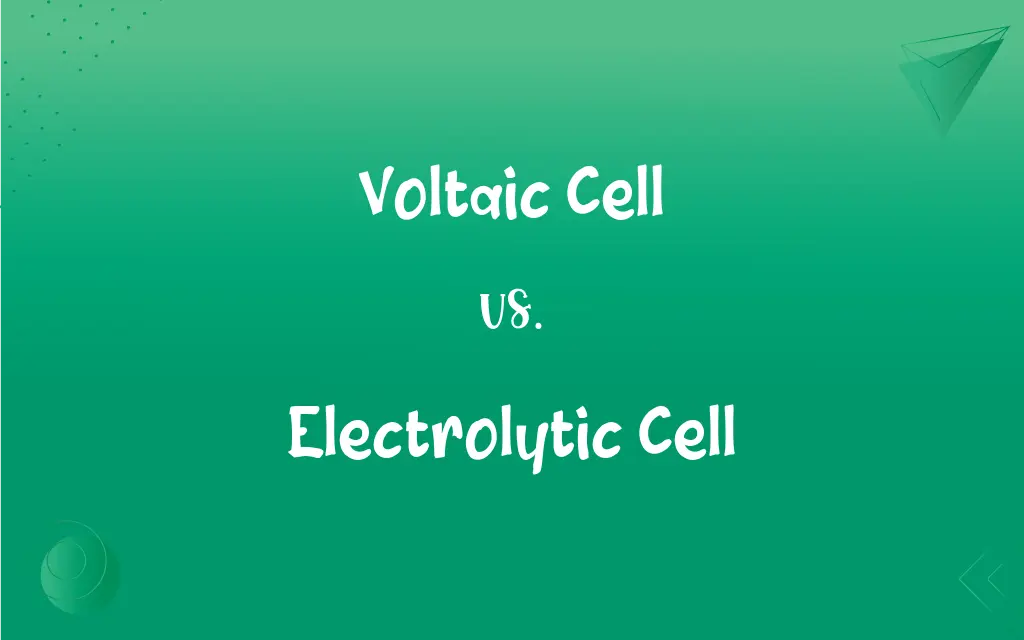Voltaic Cell vs. Electrolytic Cell: What's the Difference?
Edited by Aimie Carlson || By Harlon Moss || Published on March 1, 2024
A voltaic cell generates electricity through spontaneous chemical reactions, while an electrolytic cell uses electricity to drive non-spontaneous reactions.

Key Differences
A voltaic cell, also known as a galvanic cell, converts chemical energy into electrical energy through spontaneous redox reactions. In contrast, an electrolytic cell uses electrical energy to induce non-spontaneous chemical reactions.
In a voltaic cell, the flow of electrons is from the anode (oxidation) to the cathode (reduction), generating electrical current. In an electrolytic cell, an external power source drives electrons from the cathode to the anode, facilitating chemical reactions.
Voltaic cells are used in batteries to power devices, relying on natural chemical processes. Electrolytic cells are employed in processes like electroplating, electrolysis of water, and producing chemicals like chlorine and sodium hydroxide.
In a voltaic cell, the anode is the site of oxidation and the cathode is where reduction occurs. This is reversed in an electrolytic cell, where the cathode is the site of reduction and the anode is for oxidation.
Voltaic cells are energy-efficient, often used in situations where portable or sustainable energy is needed. Electrolytic cells require an external power source and are used in industrial or laboratory settings.
ADVERTISEMENT
Comparison Chart
Energy Conversion
Converts chemical to electrical energy
Uses electrical to drive chemical reactions
Reaction Type
Spontaneous
Non-spontaneous
Electron Flow
From anode to cathode
From cathode to anode
Common Uses
Batteries, portable power sources
Electroplating, industrial chemical production
Energy Requirement
Self-sustaining, no external power
Requires external power source
ADVERTISEMENT
Voltaic Cell and Electrolytic Cell Definitions
Voltaic Cell
Spontaneous Reaction Source.
Generates current naturally.
Electrolytic Cell
Non-Spontaneous Reaction Facilitator.
Drives chemical synthesis.
Voltaic Cell
Sustainable Energy Device.
Operates without external power.
Electrolytic Cell
Industrial Chemical Producer.
Creates chlorine gas.
Voltaic Cell
Chemical to Electrical Energy.
Powers a calculator.
Electrolytic Cell
Electrode Reaction Controller.
Reverses the typical anode-cathode roles.
Voltaic Cell
Two-Electrode System.
Consists of distinct anode and cathode.
Electrolytic Cell
Electrical to Chemical Energy.
Used in silver electroplating.
Voltaic Cell
Portable Power Solution.
Used in remote controls.
Electrolytic Cell
External Power Dependent.
Connected to a power supply.
FAQs
Can voltaic cells be recharged?
Typically, no; they're often single-use.
How does a voltaic cell work?
By spontaneous redox reactions between two electrodes.
What are common uses of voltaic cells?
In batteries and portable power sources.
Where are electrolytic cells used?
In industrial processes like electroplating.
What is a voltaic cell?
A device that generates electricity from chemical reactions.
Is a voltaic cell environmentally friendly?
It depends on the materials used.
What is an electrolytic cell?
A setup using electricity to drive chemical reactions.
Can electrolytic cells generate energy?
No, they consume electrical energy.
Do voltaic cells need an external power source?
No, they generate power spontaneously.
Are electrolytic cells used in water splitting?
Yes, to produce hydrogen and oxygen.
How does an electrolytic cell operate?
By using external power to induce reactions.
Can a voltaic cell be used in cars?
Yes, in the form of batteries.
Can voltaic and electrolytic cells be combined?
In theory, but they serve different purposes.
Is the anode positive in a voltaic cell?
No, it's negative; opposite in electrolytic cells.
Can electrolytic cells be miniaturized?
Yes, for specific applications like microelectronics.
What’s the main difference in electron flow?
Electrons flow from anode to cathode in voltaic, reverse in electrolytic.
What kind of electrolyte is used in voltaic cells?
It varies, from acids to salts.
Is the cathode in an electrolytic cell positive?
Yes, it attracts cations.
How long do voltaic cells last?
It varies, depending on usage and type.
Do electrolytic cells have environmental applications?
Yes, like in water purification.
About Author
Written by
Harlon MossHarlon is a seasoned quality moderator and accomplished content writer for Difference Wiki. An alumnus of the prestigious University of California, he earned his degree in Computer Science. Leveraging his academic background, Harlon brings a meticulous and informed perspective to his work, ensuring content accuracy and excellence.
Edited by
Aimie CarlsonAimie Carlson, holding a master's degree in English literature, is a fervent English language enthusiast. She lends her writing talents to Difference Wiki, a prominent website that specializes in comparisons, offering readers insightful analyses that both captivate and inform.































































